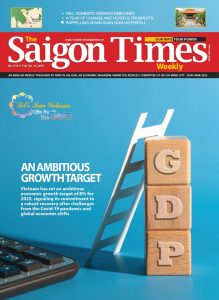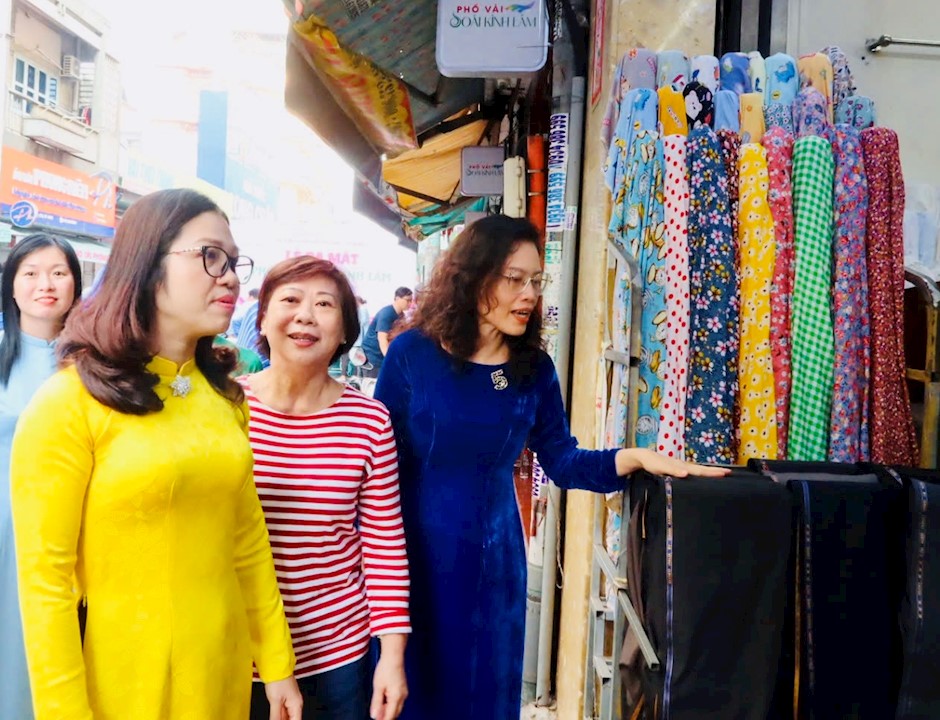Soai Kinh Lam fabric quarter was officially formed in District 5, HCMC, on the morning of January 7, with its entrance gate, brand recognition lightboxes, and canopy upgrades completed. The quarter spans three streets: Tran Hung Dao, Duong Tu Giang, and Do Ngoc Thanh.
Currently, the fabric quarter hosts 96 companies, businesses, and household enterprises. Dong Khanh Shopping Center and Satra Dong Khanh Commercial and Service Center are also contributing to the development of the fabric street.
Le Dang Tuan, vice chairman of the People’s Committee of Ward 14, District 5, said the fabric quarter’s main goal is to boost economic growth for businesses post-pandemic, offering a supportive environment for connection, collaboration, and expansion.
It also preserves and promotes the traditional cultural values of the textile industry in HCMC, contributing to promoting tourism in District 5 and establishing a destination for commercial and tourism development, according to the Tuoi Tre news site.
Westerner marries into a three-generation household in HCMC
Richard Peter, a 40-year-old British national, lives in HCMC with his wife and young daughter. His videos showcasing his experience as a “son-in-law in Vietnam” and his cultural, food, and language experiences have attracted millions of views on social media.
Peter and Hong Van held their wedding in HCMC in 2020. Initially, they lived independently, but in 2023, with their first child’s arrival, they moved into Van’s family home in Tan Phu District. Then, Richard officially lived under one roof with a three-generation family.
“Of course, there are things that surprised me as they are completely different from the culture in my hometown of Wales. For example, my father-in-law sang karaoke at home, neighbors walked straight into the backyard to ask for food and lottery ticket sellers came into the house when we opened the door,” he shared with the Thanh Nien news site.
The scent of molasses in an age-old craft village
Tho Dien Commune (Vu Quang District, Ha Tinh Province) has been well known for making molasses from sugarcane over the past five decades. These days, the craft village is busy cooking sugarcane juice to make molasses for sale on the occasion of the upcoming Tet, Vietnamese Lunar New Year holiday.
Phan Thi Huong, 55, has earned a living by making molasses for many years. She and other members of her family started harvesting sugarcanes in the 11th lunar month to make molasses for sale at the Tet season.
Huong told tienphong.vn that sugarcanes are peeled, rinsed and pressed to take sugarcane juice. Formerly, the pressing stage was done with the help of a cow or a buffalo; now this stage is done by machine. The juice is then filtered and boiled until it turns into molasses. She could turn out 100-150 liters of molasses a day.
Dang Khanh Trinh, Party secretary of Tho Dien Commune, said the locality has 30 hectares of sugarcane cultivation. Villagers can market some 190 tons of molasses per year, earning revenue of about VND10 billion.
Fashion recycling project initiated by 15 young ladies
Worried about the volume of fashion waste, 15 final-year female students at the Brand Management Faculty, School of Interdisciplinary Sciences and Arts (Vietnam National University, Hanoi) decided to launch the RE:FABRIC project to encourage old clothing recycling in a bid to protect the environment.
 Le Thi Hong Anh, head of the organizing board of the RE:FABRIC project, told thanhnien.vn that the project aims at turning pieces of cloth and old clothing into fashion products with new aesthetic values. She said this will help lengthen the lifecycle of products and thus reduce the volume of fashion waste, adding that the project has organized symposiums and fashion shows to attract more fashion designers and convey the message of sustainable fashion to the youth.
Le Thi Hong Anh, head of the organizing board of the RE:FABRIC project, told thanhnien.vn that the project aims at turning pieces of cloth and old clothing into fashion products with new aesthetic values. She said this will help lengthen the lifecycle of products and thus reduce the volume of fashion waste, adding that the project has organized symposiums and fashion shows to attract more fashion designers and convey the message of sustainable fashion to the youth.
Le Dang Thuc Han, head of the public relations board of the project, said they hope to contribute their part to changing the shopping habits of young consumers and designers, looking forward to a more sustainable future for Vietnam’s fashion and environment.
The RE:FABRIC project has received positive support from the community, especially Gen Z (those who was born from 1997 to 2012). After three months of implementation, the project has received 40kg of used clothing for recycling into new products, which have been used at its workshops and other events.











